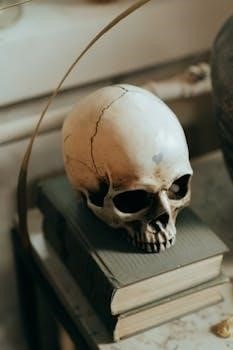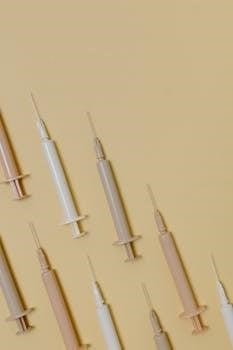Heart Anatomy Overview
The heart, a powerful muscle slightly larger than a fist, is located in the chest. It acts as a pump, circulating blood throughout the body. The heart’s anatomy comprises chambers, valves, and major blood vessels.
Basic Heart Structure
The heart is a four-chambered organ, featuring two upper chambers known as atria and two lower chambers called ventricles. These chambers are responsible for receiving and pumping blood. The heart is enclosed in a protective sac called the pericardium. The heart’s wall is composed of three layers⁚ the epicardium, myocardium, and endocardium. The myocardium, the muscular middle layer, is responsible for the heart’s contractions. The heart is positioned in the thoracic region, between the lungs. Its apex, the bottom tip, points to the left. The heart’s rhythmic beating is due to electrical impulses from the sinoatrial node. This coordinated structure ensures efficient blood circulation.

Chambers of the Heart
The heart consists of four chambers⁚ two atria (upper) and two ventricles (lower). These chambers work in a coordinated manner to ensure efficient blood circulation throughout the body.
Atria (Right and Left)
The atria are the two upper chambers of the heart, serving primarily as receiving chambers. The right atrium receives deoxygenated blood returning from the body through the superior and inferior vena cava. This blood then flows into the right ventricle. The left atrium receives oxygenated blood from the lungs via the pulmonary veins. This oxygen-rich blood is then passed down to the left ventricle. The atria have thinner walls compared to the ventricles because they do not need to pump blood out with the same force. Instead, they act as reservoirs, collecting blood before it is pumped to the ventricles. They play a key role in the cardiac cycle.
Ventricles (Right and Left)
The ventricles are the two lower chambers of the heart, responsible for pumping blood out to the body and lungs. The right ventricle pumps deoxygenated blood to the lungs through the pulmonary arteries for oxygenation. The left ventricle, the heart’s most powerful chamber, pumps oxygenated blood to the rest of the body through the aorta. The walls of the ventricles are thicker than the atria, reflecting the higher pressure needed for pumping. The left ventricle, in particular, has a very thick wall due to the high force required to circulate blood systemically. The ventricles are essential in maintaining blood flow through the body.

Valves of the Heart
The heart contains four valves that ensure one-way blood flow. These valves open and close in coordination with the heart’s contractions, preventing backflow and maintaining efficient circulation.
Tricuspid Valve
The tricuspid valve is positioned between the right atrium and the right ventricle. It features three leaflets, or cusps, hence the name “tricuspid.” This valve’s primary role is to prevent the backflow of blood from the right ventricle into the right atrium during ventricular contraction (systole). The proper functioning of the tricuspid valve is essential for maintaining the efficient circulation of blood from the body to the lungs. When the right ventricle contracts to pump blood to the lungs, the tricuspid valve closes tightly to prevent blood from flowing backwards into the right atrium. This ensures blood moves forward, which is essential for proper oxygenation and circulation.
Mitral (Bicuspid) Valve
The mitral valve, also known as the bicuspid valve, is situated between the left atrium and the left ventricle. Unlike the tricuspid valve, the mitral valve has two leaflets or cusps. Its primary function is to prevent blood from flowing backward from the left ventricle into the left atrium during ventricular systole. The mitral valve ensures that oxygen-rich blood, which has returned from the lungs, is efficiently pumped out to the rest of the body through the aorta. Proper closure of the mitral valve is essential for maintaining sufficient blood pressure and efficient oxygen delivery to the body’s tissues, thus supporting overall cardiovascular function.
Pulmonary Valve
The pulmonary valve is positioned between the right ventricle and the pulmonary artery. This valve is crucial for regulating blood flow from the heart to the lungs. It consists of three leaflets, which open to allow deoxygenated blood to be pumped from the right ventricle into the pulmonary artery and towards the lungs for oxygenation. The pulmonary valve’s primary role is to prevent the backflow of blood from the pulmonary artery back into the right ventricle during diastole, when the heart relaxes and refills with blood. Proper functioning of the pulmonary valve is vital for ensuring efficient pulmonary circulation, which is essential for gas exchange in the lungs.
Aortic Valve
The aortic valve is a crucial structure located between the left ventricle and the aorta, the body’s largest artery. This valve’s function is to control the flow of oxygenated blood from the heart to the rest of the body. It is a three-leaflet valve that opens during the ventricular contraction (systole) to permit blood to be ejected into the aorta. The valve then closes during the relaxation phase (diastole) to prevent blood backflowing from the aorta back into the left ventricle. This one-way valve action is vital for maintaining proper systemic circulation and ensuring that blood is delivered effectively to all tissues and organs, thus sustaining life.

Major Blood Vessels
The heart is connected to a network of major blood vessels, including the aorta, pulmonary arteries, pulmonary veins, and vena cava. These vessels facilitate blood flow to and from the heart.
Aorta
The aorta is the largest artery in the body, originating directly from the left ventricle of the heart. This major blood vessel is responsible for carrying oxygen-rich blood away from the heart to be distributed throughout the entire body. Its role is crucial in the systemic circulation, ensuring that every organ and tissue receives the necessary oxygen and nutrients; The aorta’s thick walls and elasticity help maintain blood pressure. It extends upward from the heart, forming an arch, before descending through the chest and abdomen, branching into various smaller arteries that supply blood to the entire body. The aortic valve prevents backflow into the left ventricle.
Pulmonary Arteries
The pulmonary arteries are unique in that they are the only arteries in the body that carry deoxygenated blood. These vessels originate from the right ventricle of the heart and transport blood to the lungs. Unlike other arteries that carry oxygenated blood away from the heart, the pulmonary arteries carry blood that needs to be oxygenated. The blood flows through the pulmonary arteries to the lungs, where it passes through the capillaries surrounding the alveoli. Here, carbon dioxide is exchanged for oxygen. The pulmonary arteries are essential for the pulmonary circulation, ensuring that the blood gets properly oxygenated before returning to the heart. They branch into smaller arteries and arterioles within the lungs.
Pulmonary Veins
The pulmonary veins are the blood vessels that carry oxygenated blood from the lungs back to the heart. Unlike most veins, which carry deoxygenated blood, the pulmonary veins are unique in that they carry oxygen-rich blood. There are typically four pulmonary veins, two from each lung, that enter the left atrium of the heart. These veins are crucial for the pulmonary circulation, delivering the freshly oxygenated blood to the heart, which is then pumped out to the rest of the body. The pulmonary veins ensure that the blood, after undergoing gas exchange in the lungs, is returned to the heart for systemic circulation. They are vital for maintaining proper oxygen levels in the blood throughout the body.
Superior and Inferior Vena Cava
The superior and inferior vena cava are the two major veins that return deoxygenated blood to the heart, specifically to the right atrium. The superior vena cava collects blood from the upper body regions, including the head, neck, and arms. In contrast, the inferior vena cava returns blood from the lower body regions such as the legs, abdomen, and pelvis. These two large veins are essential for completing the systemic circulation loop, ensuring that deoxygenated blood from the entire body is brought back to the heart for subsequent oxygenation in the lungs. Their structure and function are critical for maintaining efficient blood flow and overall circulatory health. The vena cavae are essential for the heart to receive the blood before it is sent to the lungs.

Coronary Artery Anatomy
Coronary arteries are vital for supplying the heart muscle with oxygen-rich blood. These arteries branch off the aorta and encircle the heart, ensuring its proper function.
Left Main Coronary Artery
The left main coronary artery (LMCA) is a short, yet critically important vessel that originates from the aorta. It’s often referred to as the “widow maker” due to its high risk of blockage leading to severe cardiac events. The LMCA quickly bifurcates, branching into two major arteries⁚ the left anterior descending (LAD) artery and the circumflex artery. These two branches supply the majority of the left ventricle, which is the heart’s main pumping chamber. A blockage in this artery can severely compromise the heart’s ability to pump effectively and can lead to significant damage. The health of the LMCA is crucial for maintaining adequate blood flow to the left side of the heart, making it a primary focus in cardiovascular health assessments.
Left Anterior Descending (LAD) Artery
The Left Anterior Descending (LAD) artery, often called the “widow maker’s” partner, is a vital branch of the left main coronary artery. It runs down the front of the heart, supplying a significant portion of the left ventricle, which is the heart’s main pumping chamber. The LAD artery provides blood to the front and main part of the left ventricle and the septum between ventricles, and a blockage here can have severe consequences. Due to its location and the large area of the heart it supplies, the LAD is a common site for blockages, and is a major focus for cardiac interventions. Maintaining its patency is crucial for optimal heart function.
Right Coronary Artery (RCA)
The Right Coronary Artery (RCA) is one of the two main arteries that supply blood to the heart muscle. The RCA originates from the right aortic sinus and travels along the right side of the heart. It provides blood flow to the right atrium and right ventricle. It also supplies blood to the sinoatrial (SA) node, the heart’s natural pacemaker, and the atrioventricular (AV) node, which plays a role in the heart’s electrical conduction system. Additionally, the RCA also helps to supply the posterior portion of the left ventricle. A blockage in the RCA can lead to significant cardiac issues.
Circumflex Artery
The Circumflex Artery is another major branch of the left coronary artery. It curves around the left side of the heart, in a groove between the left atrium and left ventricle. This artery supplies oxygenated blood to the left atrium and the lateral and posterior walls of the left ventricle. The Circumflex artery’s course can vary slightly from person to person. It often has smaller branches that extend to other areas of the heart; Blockages in the Circumflex can result in a variety of cardiac problems including myocardial infarction (heart attack). Its function is vital to maintain the proper functioning of the left side of the heart.